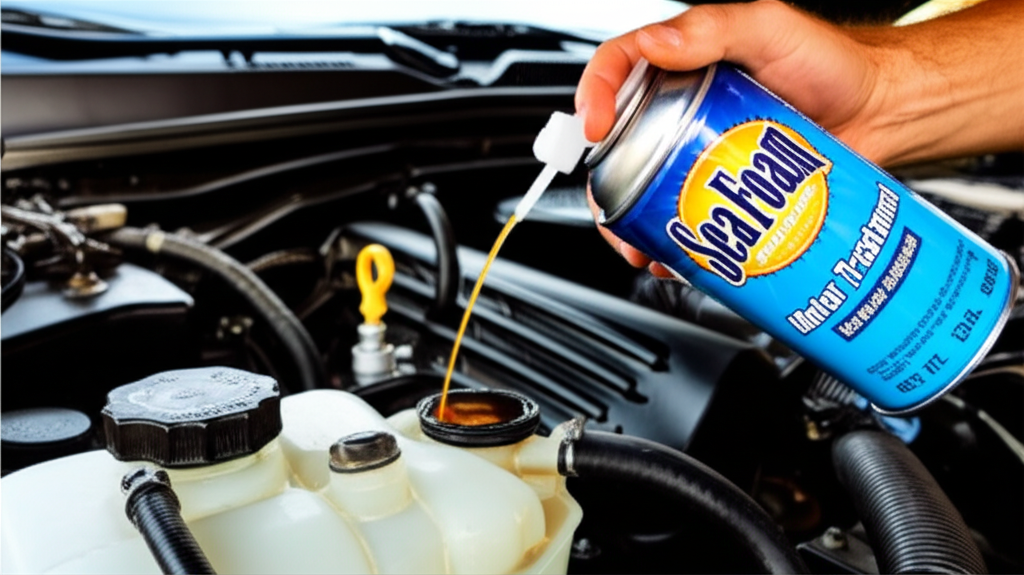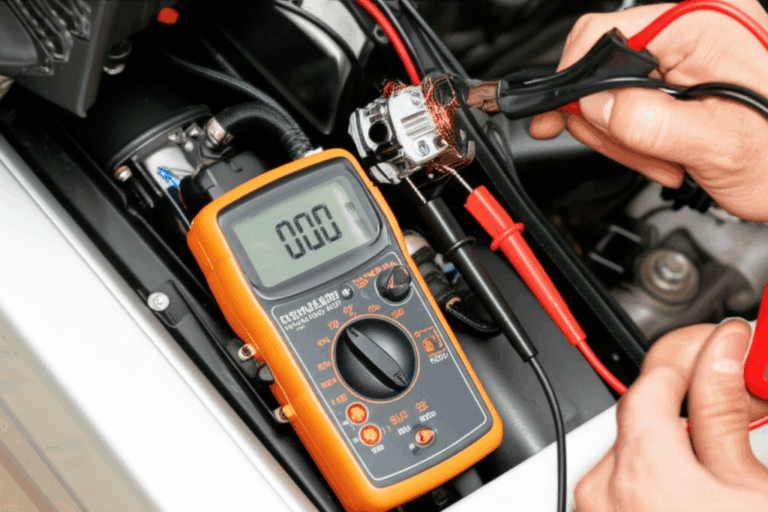
How to Use Sea Foam Motor Treatment: A Comprehensive Guide for Optimal Engine Health
Table of Contents
- What I’ve Learned About Sea Foam Motor Treatment
- Safety First: Prep, Gear, and What to Expect
- Method 1: Sea Foam in the Fuel Tank (Cleaning + Stabilizing)
- Method 2: Sea Foam in the Crankcase (Oil System Cleaning)
- Method 3: Sea Foam Through a Vacuum Line or Air Intake (Top-End Cleaning)
- Using Sea Foam Spray vs Liquid Through a Vacuum Line
- Special Cases: Small Engines, Marine, Diesel, and Two-Stroke
- GDI Engines, Carbon Buildup, and When to Target the Top End
- Troubleshooting: Smoke, Rough Running, and No Change
- Oxygen Sensors, Catalytic Converters, and Emissions Systems
- How Often Should You Use Sea Foam
- Piston Ring Soak: When and How I Approach It
- Sea Foam vs Other Additives (Like Techron)
- What Sea Foam Doesn’t Do (Scope Matters)
- Quick Reference Checklists
- Final Thoughts
What I’ve Learned About Sea Foam Motor Treatment
I started using Sea Foam Motor Treatment the way a lot of folks do. I had an engine that idled rough and fell flat under throttle. I tried the usual suspects first. Fresh fuel. New air filter. Basic maintenance. The idle still danced like a washing machine on spin cycle. Sea Foam turned out to be the nudge that engine needed.
Here’s what I’ve learned using it across cars, trucks, motorcycles, marine engines, and small engines like mowers and generators. Sea Foam is a petroleum-based cleaner and upper cylinder lubricant. It dissolves gum and varnish in the fuel system, stabilizes fuel during storage, and helps clean and lubricate the upper cylinders. When I add it to the oil before an oil change it can help free sticky lifters and rings and it can thin and move sludge toward the drain pan. When I feed it through a vacuum line or into the throttle body it tackles the hard carbon in the intake and combustion chamber.
I’ll show you the three main ways I apply it. I’ll explain dosages, how to avoid mistakes, what to expect after treatment, and how to handle special cases like GDI engines or two-strokes. I’ll also draw some clear lines on what Sea Foam can’t fix.
Safety First: Prep, Gear, and What to Expect
Before I open a can I set the stage. A few simple steps make the job cleaner and safer.
- Read the label front to back. The manufacturer’s instructions matter.
- Work in open air or a well-ventilated space.
- Wear safety glasses and nitrile gloves. Fuel and solvents are no joke around eyes and skin.
- Keep a fire extinguisher handy. Fuel vapors don’t mix with sparks.
- Expect smoke during top-end cleaning. It looks dramatic. It clears after a short drive.
- Check your vehicle manual for notes on PCV routing, vacuum lines, and any warnings about using intake cleaners.
I also look at the engine’s condition. If a vehicle barely runs because of mechanical problems Sea Foam won’t fix worn rings, a dead fuel pump, or a cracked vacuum line. It helps when varnish, carbon, or moisture in fuel created the symptoms.
Method 1: Sea Foam in the Fuel Tank (Cleaning + Stabilizing)
Purpose
- Clean fuel injectors and carburetors
- Clean fuel lines and deposit-prone spots in the fuel rail
- Lubricate upper cylinders
- Stabilize fuel for storage
- Help with water in fuel and ethanol-related issues
My go-to dosage
- General maintenance: About 1 ounce per gallon of gasoline or diesel
- Deeper cleaning: One 16 oz can for 8–25 gallons
- Small engines: 1 ounce per gallon works well
How I add it step by step
What I’ve seen in the real world
- Rough idle from dirty injectors often improves after the first tank
- Hesitation on acceleration usually smooths out once deposits dissolve
- Long-sitting fuel equipment starts easier with stabilized fuel
- On carbureted engines Sea Foam can clear tiny varnish passages that cause surging
Tips to get the most from it
- If your fuel filter is old replace it. Cleaning can move debris downstream.
- Use fresh fuel. Additives can’t fix stale gas.
- For marine engines and small engines use it before winter. It keeps fuel fresh and helps prevent gum and varnish that clog jets.
Common questions
- Is Sea Foam safe for oxygen sensors and catalytic converters when used in fuel? In my experience yes at recommended dosages because it burns with the fuel. I avoid double-dosing or stacking it with other strong additives in the same tank.
Method 2: Sea Foam in the Crankcase (Oil System Cleaning)
Purpose
- Clean oil passageways and varnish-laden spots
- Free up sticky lifters
- Help loosen stuck or carboned piston rings
- Thin and move sludge so it drains out with the oil
Dosage I use
- About 1.5 ounces per quart of oil
- One 16 oz can treats roughly 5 quarts of oil
How I do it
What I’ve seen after crankcase use
- Lifters tick less when varnish isn’t holding them up
- Oil turns dark fast because it’s suspending dissolved deposits
- Engines with minor ring stick sometimes use less oil afterward
Handy reminders
- If the oil is already due change it first then add Sea Foam to fresh oil for a short run and change it again if you want a more conservative approach
- Watch oil pressure and level. If anything feels off end the test and change oil
Method 3: Sea Foam Through a Vacuum Line or Air Intake (Top-End Cleaning)
Purpose
- Clean intake valves and ports
- Clean the combustion chamber and piston crowns
- Lubricate upper cylinders
- Help reduce spark knock and pre-ignition from carbon hot spots
This is the most aggressive method and it works well when the top end is loaded with carbon. It requires care. You can hydrolock an engine if you dump liquid into an intake too fast.
Dosage I use
- About one third to one half of a 16 oz can for most 4 to 8 cylinder engines
- I rarely go over that amount in one session
Step-by-step method I follow
What to expect
- Heavy white or gray exhaust smoke right after the restart. This is normal and it clears within a few miles.
- Idle can stumble at first. Give it a few minutes of driving and it usually smooths out.
When I skip this method
- If a vehicle has a weak ignition system or a misfire that I haven’t diagnosed yet I fix that first
- If the engine ingests oil through a bad PCV system or a turbo seal I address the root cause before adding more liquid to the intake
Using Sea Foam Spray vs Liquid Through a Vacuum Line
Sea Foam Spray delivers the product through a straw into the throttle body while you hold rpm. It’s simpler for many cars because it meters the flow and reduces hydrolock risk. I use it when:
- The brake booster line is hard to access
- The car uses a complex PCV routing
- I want to target the throttle body and intake a bit more precisely
The general idea stays the same. Warm engine. Controlled application. Soak. Drive.
Special Cases: Small Engines, Marine, Diesel, and Two-Stroke
Small engines (mowers, generators, chainsaws)
- I add 1 ounce per gallon of fuel for cleaning and stabilization
- If a carburetor surges at idle I run a treated tank. Often the surging fades as varnish clears
- For storage I top off with treated fuel and run it long enough to pull stabilized fuel into the carb
Marine engines (outboard and inboard)
- Water and ethanol cause headaches on the water. I use Sea Foam as a stabilizer and moisture control to keep fuel fresh
- Before storage I run treated fuel and fog the engine if the manufacturer recommends it. With traditional fogging I feed spray into the carburetor or intake until the engine stalls which coats surfaces against corrosion. Sea Foam spray products can play a role in that routine but I always follow engine maker guidance
Diesel engines
- Diesel fuel systems benefit from detergent cleaning and upper cylinder lubrication. I stick to 1 ounce per gallon unless the label says otherwise
- For modern diesels with high-pressure injection I keep it in the tank only. I don’t run liquid cleaners through intake plumbing on diesels unless a product is made for that system
Two-stroke engines
- I treat the fuel mix at 1 ounce per gallon
- I do not add Sea Foam to two-stroke oil reservoirs directly
- For older two-strokes that sat all winter stabilized fuel prevents gum and lean bog
GDI Engines, Carbon Buildup, and When to Target the Top End
Gasoline Direct Injection (GDI) engines can collect heavy carbon on intake valves. Fuel doesn’t wash those valves because injection happens in the cylinder not in the port. Symptoms often include:
- Rough cold starts
- Hesitation or misfire at low rpm
- Reduced fuel economy and throttle response
Fuel tank treatments still help injectors and combustion but they won’t scrub intake valves on GDI engines. That’s where a top-end cleaning through the intake or a professional service shines. I lean toward the intake method when:
- A borescope shows carbon on intake valves
- The engine pings on regular fuel even with clean plugs and fresh oil
- Idle hunts after warmup with no fault codes
If the buildup is severe a professional walnut blast or chemical service may be a better fit. Sea Foam can be part of a maintenance routine to slow the return of deposits.
Troubleshooting: Smoke, Rough Running, and No Change
Smoke after treatment
- Expect a smoke show after an intake cleaning. It should fade fast once deposits burn off
- A light haze after a fuel-tank-only treatment can happen on older engines but it’s usually minor
Engine runs rough right after
- If you used the vacuum line method let the engine clear out for 5–10 minutes
- Check for any vacuum hose you forgot to reconnect
- If a spark plug was already weak a heavy cleaning can push it over the edge. I check plugs and coils if the misfire persists
No noticeable change
- You might have a mechanical or electrical issue not related to deposits
- Try another tank treatment if you cleaned only once and the system was very dirty
- Scan for codes. A lazy oxygen sensor or a failing fuel pump won’t improve with cleaners
Oxygen Sensors, Catalytic Converters, and Emissions Systems
I get asked a lot if Sea Foam harms oxygen sensors or catalytic converters. Used as directed I haven’t seen problems. It’s designed to burn cleanly with fuel and leave minimal ash. I avoid stacking multiple strong additives in the same tank because that can spike combustion byproducts. When I do an intake cleaning I follow dosage rules and let the engine get fully hot on the post-clean drive cycle so the catalyst lights off and clears residual vapors.
If your catalytic converter is already borderline because of oil burning nothing you pour in the tank will fix the underlying cause. Sea Foam can help engines run cleaner which reduces stress on emission components over time.
How Often Should You Use Sea Foam
I use it based on the engine’s behavior and my maintenance rhythm.
- Fuel system maintenance: Every 3,000–5,000 miles or every few tanks in vehicles that do lots of short trips. For small engines and marine gear I add it before every storage period and a few times during the season.
- Oil system cleaning: Only 100–300 miles before an oil change. I use it when I hear lifter noise or suspect ring stick not at every single change.
- Intake cleaning: As needed. If you feel rough idle, pinging, or sluggish response and other basics check out an annual top-end clean can help especially on GDI engines.
Piston Ring Soak: When and How I Approach It
If I suspect stuck piston rings because of low compression on one cylinder or rising oil consumption I sometimes do a ring soak. This is an advanced move and it demands caution.
What I do
I only do this after confirming the engine doesn’t have deeper mechanical issues. If you’re not comfortable with plug removal and safe cranking skip this or ask a pro.
Sea Foam vs Other Additives (Like Techron)
Different deposit control additives use different chemistries. Techron leans on strong detergents for injectors and valves on port-injected engines. Sea Foam brings cleaning plus upper cylinder lubrication and fuel stabilization. I don’t mix them in the same tank. I pick one based on the goal then switch next interval if I want to try the other. If injectors are the only concern Techron can do a fine job. If I want lubrication plus moisture handling and general cleaning Sea Foam fits that role.
What Sea Foam Doesn’t Do (Scope Matters)
Sea Foam is for internal combustion engines and fuel systems. It won’t fix electrical faults or clean components inside electric motors. That includes the alternator in your car which uses a stator and rotor with laminated steel for magnetic efficiency. If you’re diving into electric machine design the quality of the stator core lamination and the matching rotor core lamination matters a lot for performance. Those parts rely on precision electrical steel laminations and careful stacking. If you work with custom machines you’ll also care about overall motor core laminations quality. None of that changes how you use Sea Foam. I include it here to draw a clear line. Use Sea Foam for fuel, oil, and intake deposits not for electric motor internals.
Quick Reference Checklists
Fuel tank method
- Purpose: Clean injectors or carburetors, stabilize fuel, lubricate upper cylinders, handle moisture
- Dosage: 1 oz per gallon for maintenance or 1 can per 8–25 gallons for deeper cleaning
- Steps:
- Add to a low tank for stronger cleaning or a full tank for stabilization
- Fill with fresh fuel
- Drive normally for 1–2 tanks
- Good for: Rough idle, hesitation, storage prep, poor fuel quality
Crankcase method
- Purpose: Free sticky lifters and rings, thin sludge for drainage, clean oil passages
- Dosage: Around 1.5 oz per quart of oil
- Steps:
- Add to warm oil 100–300 miles before an oil change
- Drive gently and monitor oil level
- Change oil and filter on schedule
- Good for: High mileage engines, suspected oil sludge, light lifter noise
Vacuum line or intake method
- Purpose: Clean intake valves, combustion chambers, piston tops
- Dosage: 1/3 to 1/2 can
- Steps:
- Warm engine
- Identify a main vacuum line or use Sea Foam Spray through the throttle body
- Feed slowly to avoid hydrolock
- Soak 5–15 minutes
- Drive hard enough to burn off deposits
- Good for: Rough idle, misfires tied to deposits, throttle response issues, GDI valve deposits
Small engines and marine
- Dosage: 1 oz per gallon in fuel
- Storage: Treat and run long enough to get stabilized fuel into the carb or injectors
- Marine: Treat before winter and consider fogging per manufacturer’s instructions
Troubleshooting
- Heavy smoke: Normal after intake cleaning
- Runs worse right after: Let it clear then verify hoses and plugs
- No change: Scan for codes and check ignition or fuel pressure
Final Thoughts
I keep Sea Foam in my toolkit because it solves a specific set of problems well. It cleans gum and varnish in the fuel system. It stabilizes fuel for storage. It lubricates the upper cylinders. It helps free sticky lifters and piston rings when I add it to oil for a short pre-change run. It tackles carbon when I meter it through the intake then follow with a solid drive cycle.
Use the right method for the symptom. Measure your dosage. Respect soak times. Expect smoke after an intake clean then let the engine stretch its legs to finish the job. If symptoms don’t change you likely have an issue that needs repair not a cleaner.
I’ve seen engines idle smoother and pull harder with simple treatments. I’ve also learned when to stop pouring and start diagnosing. That balance makes Sea Foam a useful tool rather than a magic potion. Use it well and your engine will thank you with cleaner combustion, fewer hiccups, and a longer, healthier life.








